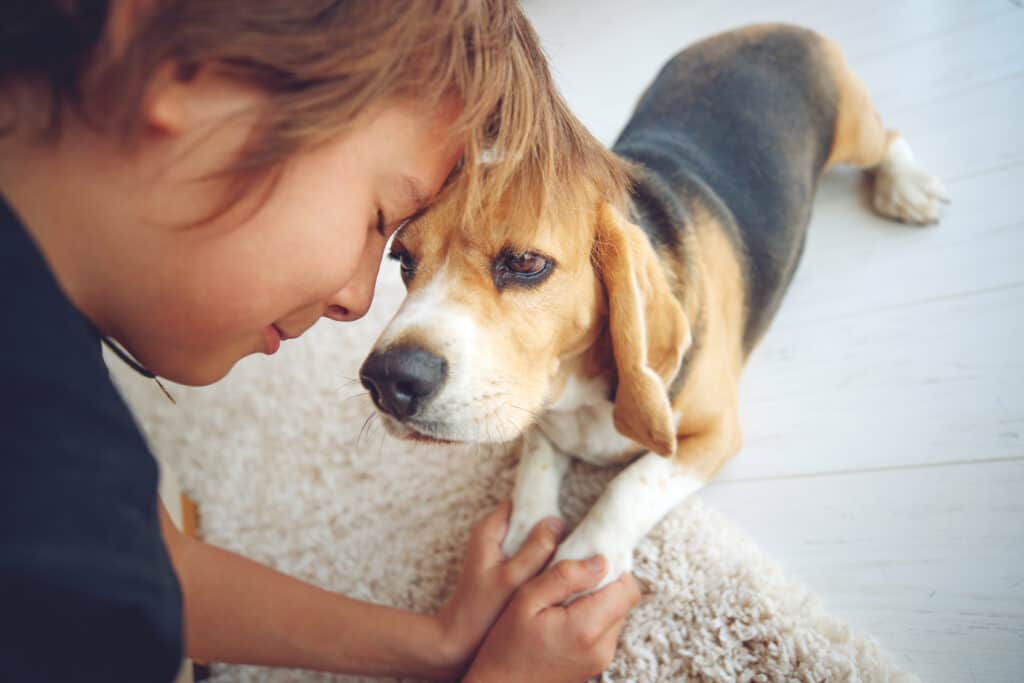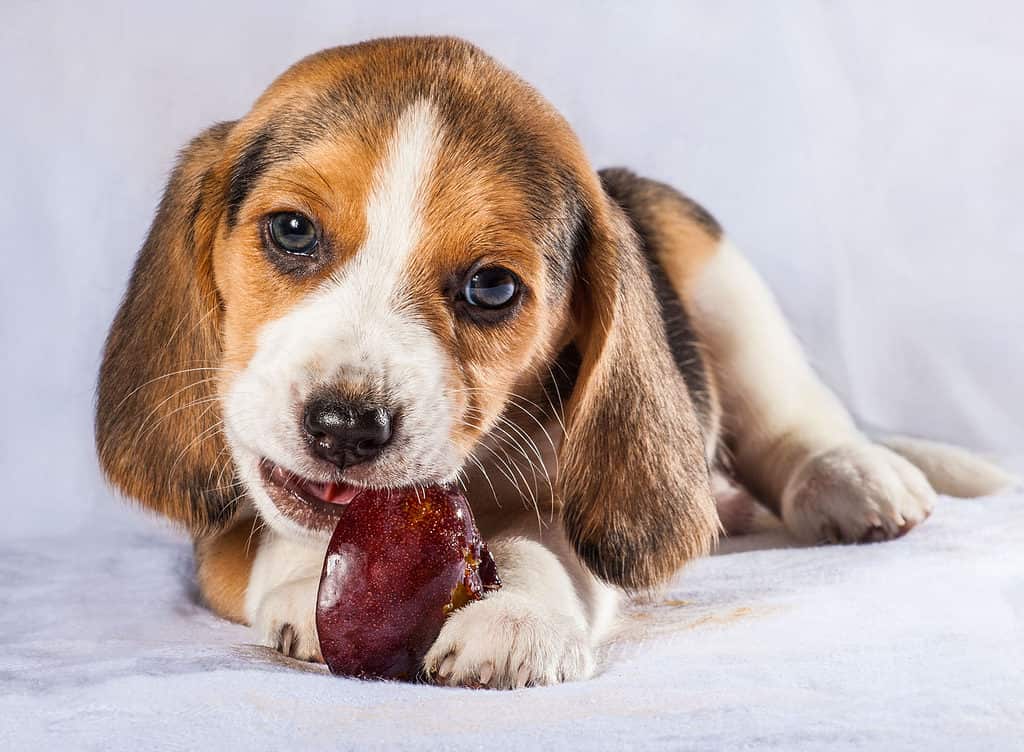The beagle is a droopy eared, compact, and adorable hound that many of us know and love. They were once bred to be impressive scent hounds that track small prey. However, this breed has now transitioned into a loving companion. They do well in active homes, both with and without children. A beagle is a wonderful addition to a variety of families. There are some unique traits you should know about the beagle before welcoming one into your family. We want you to have the tools to be the best beagle parent possible! So, let’s dive into beagle progression, feeding tips, and health issues.
Let’s get started!
Brief Beagle Summary

Beagles provide companionship to their treasured family members.
©Nina Buday/Shutterstock.com
The beagle is an inquisitive, hardworking, and gentle canine friend. Originally utilized to assist their owners in tracking small prey, the beagle now fills a variety of important roles. You can now find the beagle working in drug and illegal fruit detection at international airports. They also work in search and rescue missions. And of course, they provide companionship to their treasured family members.
The beagle is known for being incredibly friendly, which is one of the reasons why the breed has become so popular over the years. Though they are kind natured, they are also very intelligent. This means potential owners need to be prepared to offer them plenty of daily stimulation and a consistent training program. Overall, the beagle can be the perfect addition to the right family.
Beagle Growth and Weight Chart – Month to Month
The beagle is considered a small hound, so you won’t see any drastic growth throughout their life. However, it’s always good to have an idea of what to expect as they transition from puppyhood to adulthood. Let’s break down your beagle’s estimated growth over the first year of life.
| Age | Female weight | Male Weight |
|---|---|---|
| Birth | Under 1 pound | Under 1 pound |
| 1 Month | 2-3 pounds | 3-4 pounds |
| 6 Weeks | 2-3 pounds | 3-4 pounds |
| 2 Months | 3-5 pounds | 4-7 pounds |
| 3 Months | 7-10 pounds | 8-11 pounds |
| 4 Months | 8-11 pounds | 9-12 pounds |
| 5 Months | 9-12 pounds | 10-13 pounds |
| 6 Months | 12-14 pounds | 14-18 pounds |
| 7 Months | 14-16 pounds | 16-20 pounds |
| 8 Months | 16-17 pounds | 18-22 pounds |
| 9 Months | 17-20 pounds | 20-26 pounds |
| 10 Months | 18-20 pounds | 20-28 pounds |
| 11 Months | 18-20 pounds | 20-30 pounds |
| 12 Months | 18-20 pounds | 20-30 pounds |
| 2 Years | 18-20 pounds | 20-30 pounds |
The above weight ranges are typical of beagles. However, the best way to know how much your beagle will weigh at adulthood is by looking at their parents.
When Should My Beagle Stop Growing?
The beagle is considered a small-sized hound, so they will reach maturity much earlier than their large canine friends. Some dogs will grow until they are two years of age. But your beagle pup should stop growing once she reaches 10 months. However, she may put on a few extra pounds over the next three to six months.
When Should My Beagle Stop Eating Puppy Food?

It’s best to feed your Beagle a puppy diet until they are 10 months of age.
©iStock.com/Przemysław Iciak
Feeding your growing beagle a puppy kibble is one of the best ways to make sure he grows into a healthy adult. Puppy food is packed with essential nutrients that promote optimal growth. It also provides a higher calorie per cup content that keeps up with energy needs.
Pups should be fed a puppy food until they have completed the majority of their growth. For beagles, this means a diet made for puppies until they are 10 months old. Once your beagle reaches 10 months of age, you can transition him over to an adult dog food made for small breed dogs. Just be sure to transition over a two-week period, as this can prevent any GI upset from the diet switch.
How Big Will My Beagle Be as an Adult?
It’s time to discuss how big your beagle will be once she reaches full maturity. This can vary slightly from male to female beagles. But you can typically expect your adult to weigh anywhere from 18-30 pounds.
Most beagle companions will not fall outside of this average range. That being said, if you want a more accurate estimate, your beagle’s parents are the best indicator. This is why we always suggest seeing your puppy’s parents in person before you adopt.
When Should My Beagle Start & Stop Losing Teeth?
Just as you and I had a set of baby teeth we lost throughout our childhood, our beagle pups are no different. It may not take them years to ditch their baby teeth completely, but they undergo a similar teething process.
In most beagle puppies, you will typically see their baby teeth erupting from their gums around the three-week mark. These teeth will grow in over the span of three to four weeks, and most beagle puppies will have a full mouth of baby teeth by the time they reach six to seven weeks of age.
Your beagle puppy will complete the first step in their teething process around six to seven weeks of age, but they will soon dive into the next process in their teething journey once they reach 12 weeks of age. The beagle’s permanent teeth will begin to grow around the three-month mark, eventually pushing out each baby tooth one by one. This will continue for the next three months, but your beagle should have a mouth full of permanent teeth by the time she reaches six months of age.
When Should I Start Training My Beagle?
As we mentioned above, the beagle is very smart. Though many assume this will make the training process easy, it can actually be the opposite. The beagle is also quite stubborn, so paired with their intelligence, obedience training can be challenging at times. For this reason, we suggest diving into the training process from the moment you adopt.
Though training a beagle can be challenging at times, once you figure out what works for your pup, he will catch on quite easily. Just be sure to be consistent with your approach, and to always use positive reinforcement through the training process.
The beagle is known for being highly food motivated, so using treats as a reward is very effective for many beagle pups.
What Commands Should I Teach My Beagle First?
If you are about to dive into the training process with your beagle, then you may struggle with which commands you should teach first. Though the priority of certain obedience commands will vary based on what’s essential for your home, we suggest teaching the following commands first:
- Sit
- Stay
- Lay down
- Come
- Drop it
Not only should you focus on basic obedience commands, but you should also prioritize socialization. A beagle that doesn’t experience life outside the home can struggle with fear and aggression, and it can be challenging to manage over time. Introducing your beagle to new dogs, new people, new settings, and new sounds can help him become the well-rounded family pup you’ve always wanted.
Though socializing your beagle is essential throughout the training process, just remember that your puppy should not interact with any unvaccinated or unfamiliar dogs before she has received all three puppy vaccines. These vaccines protect against parvovirus and distemper virus, and pups will be susceptible to these conditions until they have completed this series. Once your beagle is fully vaccinated, you can bring her to public settings where unknown pups are present.
When Should My Beagle Be House Broken?

Beagles can be trained, despite a reputation for being a bit stubborn.
©Maria Sbytova/Shutterstock.com
We’ve mentioned that beagles can be a bit stubborn throughout the training process, but this appears to be even more prevalent when it comes to potty training. The beagle has a reputation for being particularly difficult to house train, so you will need to be up for the challenge if you plan to be a beagle parent!
A successful potty training process for a beagle will involve feeding at the same times each day, taking him outside multiple times each day, and offering plenty of positive reinforcement and praise along the way. The beagle is very food motivated, so you can always use this in your favor throughout the house breaking process.
If you are consistent with your approach to potty training, then most beagles should be housebroken within six to eight months of the training process being implemented.
When Should My Beagle Be Spayed or Neutered?
You may be curious as to when your pup should be spayed or neutered. Sterilizing your beagle can offer a variety of health benefits, and it can come with behavioral benefits as well. Spaying or neutering can prevent unwanted litters, decrease the risk of reproductive cancers, and even cut down on undesirable hormone-driven behaviors.
You may find different options about the topic, but on average, most veterinary experts will agree that sterilizing between the ages of six months to one year is best. Sterilizing them over the age of one year can increase their risk of developing reproductive cancers down the line.
Common Health Issues Seen in Beagles
Most beagles will live a long and happy life of anywhere from 10 to 15 years, but they are at risk of developing a few common health conditions over the years. As long as you are aware of the potential health threats, then you can get them the proper care they need from the time their symptoms develop.
Intervertebral disc disease
Intervertebral discs exist between each of the bones in the canine spine. These discs prevent the bones of the spine from rubbing together, essentially acting as a cushion. When a dog has IVDD, this means the jelly-like inner layer of the disc has begun to protrude outside of the disc itself, causing it to push into the spinal space and compress the dog’s spinal cord. This can cause serious pain, and it can even lead to complete paralysis as it progresses. Common symptoms of IVDD include limping, stiffness, abnormal posture, limb weakness, crying out when touched, trembling, and paralysis.
Cherry Eye
Cherry eye occurs when the gland under the dog’s third eyelid begins to protrude. This causes a red lump in the corner of the eye, and it can interrupt natural tear production. Not only is it a cosmetic issue, but dogs with chronic cherry eye can suffer from dry eyes until it is resolved surgically.
Epilepsy
Epilepsy is a neurological disorder that often leads to seizures. Most cases of epilepsy develop when the dog is between the ages of one to three years of age, and it can cause symptoms ranging from minor tremors to convulsing. Though epilepsy can be scary, many cases can be managed long term with seizure medications from your vet.
Glaucoma
Glaucoma is a painful eye condition that causes the pressure within the eye to reach abnormally high levels. This occurs when natural fluid within the eye is unable to drain properly, causing it to build up without an option for exit. This will not only be incredibly painful for dogs, but it can lead to blindness if it is not resolved quickly. Common symptoms of glaucoma include eye redness, pawing at the eyes, swelling of the eye, watery eyes, frequent squinting, and light sensitivity.
Patellar luxation
Patellar luxation occurs when the dog’s kneecap slips out of place. This can be painful for the dog in the moment, but it can also lead to damaging inflammation and eventual arthritis in the joint. Some of the most common signs of patellar luxation in dogs include sudden limping when moving, skipping when running, and lameness of the affected limb. Severe cases of patellar luxation can be surgically revised to prevent future complications.
In Summary
Not all beagles will suffer from the complications we discussed above, but it’s always best to be on the lookout for symptoms these conditions can cause. Most complications can be managed long-term with veterinary care, so it’s always best to have your pup seen from the moment you are concerned.
Pictures of Beagles as Puppies

Adorable beagle puppies love a good chew toy.
©NinaM/Shutterstock.com

Did you know tiny beagle puppies excel at soccer?
©iStock.com/jarun011

This beagle puppy is learning how to howl.
©iStock.com/Thanawath Seangsuriyapone
Pictures of Beagles at 6-8 Months of Age

A teenage beagle puppy will be nearing adult size.
©Lunja/Shutterstock.com
Pictures of Fully Grown Beagles

Beagles make wonderful, affectionate companions.
©Aleksandr Finch/Shutterstock.com

Beagles are great at tracking a scent outdoors.
©iStock.com/androsov58

Beagles can live for 10 to 15 years.
©bunthaweekan anpunya/Shutterstock.com
Do you think the beagle is the right canine companion for your family? Be sure to review the information we discussed above, so you can better understand each aspect of being a beagle parent!
The photo featured at the top of this post is © eAlisa/Shutterstock.com
Ready to discover the top 10 cutest dog breeds in the entire world?
How about the fastest dogs, the largest dogs and those that are -- quite frankly -- just the kindest dogs on the planet? Each day, AZ Animals sends out lists just like this to our thousands of email subscribers. And the best part? It's FREE. Join today by entering your email below.
Thank you for reading! Have some feedback for us? Contact the AZ Animals editorial team.






